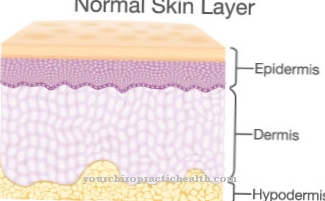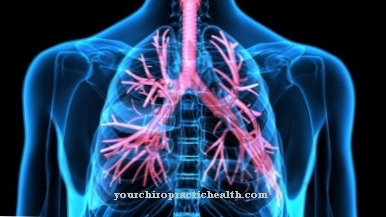Under a Shin splints is understood the appearance of pain on the leading edge of the tibia. The symptoms mainly show up after sporting activities.
What is Shin Splint Syndrome?

© Aksana - stock.adobe.com
In medicine it will Shin splints also as Tibial Edge Syndrome or Shin splint syndrome designated. What is meant is a chronic pain syndrome that occurs primarily after physical activity such as intense jogging. The same applies to all types of sport that place greater stress on the muscles of the shinbone. The often slow healing process is considered problematic.
causes
Shin splints are usually caused by intense running training, long hikes and sports such as long jump or high jump. Basically, however, any sport can trigger a shin splint syndrome that leads to intense movements. Skateboarding is also part of it.
In athletes, the shin splints is one of the most common sports-related complaints and ranks 3rd. The cause of the pain is the replacement of the floor coverings in spring and autumn, technical changes in speed running within interval training and extensive marathon training.
The sudden increase in the pace of running or the amount of exercise can also be responsible for the occurrence of the shin discomfort. Another possible trigger could be wearing the wrong footwear. However, the most common cause of tibial splint syndrome is constant jumping and landing.
Athletes who have pronation, whose foot rotates in the outward direction and who use spikes are also particularly affected. In addition to athletes, dancers and soldiers often suffer from the pain syndrome.
Symptoms, ailments & signs
A tibial edge syndrome is noticeable by the sudden onset of severe pain on the edge of the tibia. If the load is reduced, the pain goes down again. If the load increases again, the affected athlete immediately feels pain again.
Doctors differentiate between two forms of tibial splint syndrome. So there is the medial and the lateral tibial edge syndrome: In the medial tibial edge syndrome, the pain occurs in the lower section of the tibial edge. The lateral shape, on the other hand, shows up in the upper tibia.
The pain is felt to be either sharp or dull. While they initially only appear when moving, they can also appear in the rest state later on. Due to the strong pressure on the affected areas, the skin is sometimes very elastic. The skin tension can also cause pain.
Some patients also experience sensitivity disorders in the tight areas of the skin. In some cases, the strong pressure affects the muscles, which in turn restricts certain muscle movements. Sometimes necroses also form in the affected muscle areas. This can cause further symptoms such as fatigue and a high fever. In the worst case, life-threatening sepsis (blood poisoning) sets in.
Diagnosis & course of disease
If there is a suspicion of tibial splint syndrome, the attending physician first conducts a detailed discussion with the patient. He asks about the stresses under which the complaints occur and whether they have appeared on previous occasions. The running quota of the patient and whether they have pre-existing thromboembolic diseases also play an important role.
A physical examination will take place after the anamnesis. A swelling can usually be seen along the edge of the shin. If the doctor puts pressure on the swelling, pronounced pain becomes apparent. In addition, the doctor uses imaging examination procedures such as taking x-rays.
In this way, stress fractures or inflammation on the periosteum can be determined. It is also possible to carry out magnetic resonance imaging or scintigraphy. These procedures are mainly used when a stress fracture is suspected.
Differential diagnoses are also important in order to rule out other diseases that may cause complaints of this type.It is a compartment syndrome, a peripheral arterial disease of the lower limbs and venous outflow disorders.
The course of a tibial splint syndrome varies greatly from patient to patient. While the symptoms only last a few hours for some people, others suffer from them for several weeks. If the shin is not spared, the pain will increase in intensity and the disease will last longer.
Complications
With this syndrome, those affected primarily suffer from very severe pain. The pain mainly occurs on the shin, so that there can also be restrictions in movement and thus in the everyday life of the person concerned. As a rule, the pain occurs during exercise. However, they can also appear in the form of resting pain and cause discomfort at night.
As a result, many patients also suffer from insomnia or mental disorders. Paralysis or other disorders of sensitivity can also occur due to the tibial splint syndrome and continue to complicate everyday life for the person affected. Necroses develop and those affected often appear tired and exhausted. Furthermore, the tibial splint syndrome can also lead to blood poisoning, which in the worst case can lead to death of the person concerned.
The syndrome can also lead to a severe fever. Treatment of this syndrome can usually be done with the help of medication. There are no complications. However, many sufferers are also dependent on various exercises to restore mobility. The life expectancy of the patient is also not negatively affected by the syndrome.
When should you go to the doctor?
A visit to a doctor is usually necessary for shin splints. It cannot heal itself, so that the disease must always be examined and treated by a doctor. This is the only way to prevent further complications and complaints. A doctor should be consulted if the person concerned is suffering from very severe pain in the shin.
The pain can take the form of stress pain or rest pain and have a very negative effect on the quality of life of the person concerned. Above all, sharp pain is an indication of the tibial splint syndrome and should be examined by a doctor if it occurs over a long period of time.
Furthermore, if the symptoms persist over a long period of time, a high fever or severe fatigue also indicates the tibial splint syndrome. If the shin splints are left untreated, in the worst case scenario blood poisoning can occur. Shin splint syndrome is diagnosed and treated by an orthopedic surgeon. In emergencies or acute pain after an accident, you can also go to the hospital or call an emergency doctor directly. The life expectancy of the person affected is usually not reduced by this disease.
Treatment & Therapy
As a rule, tibial splint syndrome is treated conservatively. The focus is particularly on protecting the legs. If further training is required, it must be limited to exercises that do not put strain on the shin. These include cycling or swimming.
In the case of acute tibial edge syndrome, the patient can put on ointment bandages with pain relievers. Another option is to take pain reliever pills. If these treatments do not improve, a cortisone solution can be injected into the affected areas. Physiotherapy exercises are also considered helpful. If the symptoms persist despite conservative therapy measures, surgical intervention can be useful.
The surgeon splits the muscle's fascia in order to lower the pressure. For this purpose, minimally invasive endoscopic procedures are increasingly used instead of open interventions. The chances of success of the operation are assessed as positive. More than 60 percent of all patients no longer felt any symptoms after the procedure. After about four weeks, the patient can go back to exercise.
You can find your medication here
➔ Medicines for painprevention
To prevent shin splints, preventive measures are possible. The athlete should not increase the amount of his training per week by more than ten percent. In this way he gives his tendons and muscles enough time to prepare for the new loads. Matching running shoes are also important.
Aftercare
Those affected should urgently wear shin guards when doing any sport. This can offer sufficient protection against complications in the event of accidents and unwanted external influences. If the person experiences pain or other complications, they should take a break immediately. In such a case, the affected shin must be sufficiently spared.
Those affected should generally take it easy and rest a lot so that they can improve quickly. All activities that are carried out should therefore urgently be adapted to the disease. This also applies to the job. If a job is exercised in which the shin is heavily stressed, the sick should consider changing this job.
Physiotherapy should also be sought. There, those affected can learn how to avoid bad posture so that there is no additional strain on the shin. The shoes of those affected must also be adapted to the disease. The size of the shoes must be adapted to the foot and the shoes should have no or only limited heels.
Those affected should consider putting insoles in their shoes. This can lead to quick relief of the symptoms. Those affected should also make sure that they prevent one-sided strain on the body, because this can also worsen the symptoms.
You can do that yourself
When performing sports activities, adequate protection of the shin should be worn. This helps against unwanted external influences, cushions any accidents and can protect against severe stress. If the first disturbances or impairments occur, phases of rest must be taken and the body must be sufficiently spared. A period of regeneration is needed so that symptoms can be alleviated and improvement occurs.
In principle, the performance of physical activities must be tailored to the needs of the person concerned and his or her organism. Avoid situations of overload. In everyday life, physiotherapeutic exercises can be carried out on your own, so that there is no improper stress or an incorrect posture is assumed. The shoes worn must be checked and, if necessary, optimized. The heels shouldn't be too high and the shoe should be tailored to the size of the foot.
In some cases, the symptoms are already relieved when insoles are worn. In addition, it must be checked on which floor covering the person concerned moves most of the time. A surface that is too hard can, for example, trigger an increase in physical irregularities when running. As part of self-help, it is important to ensure that one-sided physical stress is avoided. These can have a negative impact on the skeletal system or the muscles.

.jpg)
.jpg)






















.jpg)


